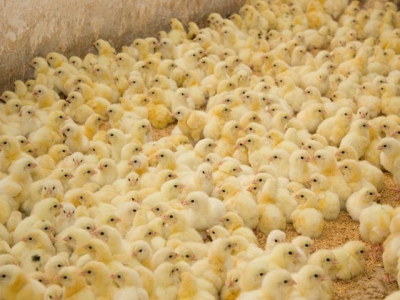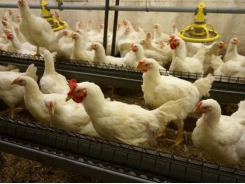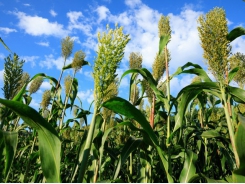Strategy to reduce the immunotoxic effects of aflatoxins in broiler chicks

Diet supplementation with mannanoligosaccharide (MOS) improved immunological responses and increased humoral immunity in aflatoxin-challenge broilers, finds a study from Iran.
Adding the prebiotic to the broiler chick ration also boosted cellular immunity and modulated immunological gene expressions in birds challenged with the mycotoxin, said the scientists.
“Aflatoxin contamination of diet not only depressed humoral and cellular immune responses in broiler chicks, but also it diminished T and B cells growth and differentiation at the gene expression level, mainly through downregulation of IL-2 gene expression. On the other hand, MOS supplementation of [the] diet could improve immunological responses in aflatoxin-challenged birds, probably by fortifying hepatic IL-2 gene expression,” found the study published in Preventive Veterinary Medicine.
The Iranian researchers said very little information is available on the effects of dietary inclusion of MOS on hepatic gene expressions and humoral and cellular immune responses in aflatoxin-challenged birds. Hence, the reason for their investigation.
Among prebiotics, mannanoligosaccharides (MOS), derivatives of the cell wall of yeast Saccharomyces cerevisiae, are well known as non-digestible feed ingredients, and have been found to be beneficial for the host by motivating the growth or metabolic activity of intestinal microorganisms (Chand et al., 2016), noted another paper.
Benefits of MOS
They said that several inorganic adsorbents have been applied to control the toxic effects of mycotoxins (Santin et al., 2002a; Thieu et al., 2008), with organic adsorbents such as MOS and β-glucan derived from yeast cell wall attracting a lot of attention (Khan et al., 2017).
“Yeast and yeast cell wall components ameliorate the deleterious effects of mycotoxins (Huwig et al., 2001). The cell wall components, especially β-glucans, play the strongest role in mycotoxins adsorbent capability (Yiannikouris et al., 2004),” added the Iran-based scientists.
Glucomannan derived from Saccharomyces cerevisiae sequestrates the toxins and prevents them from being absorbed in gastrointestinal tract of animals as previously proposed by Jouany et al. (2005), they said.
Besides the adsorbent capacity, yeast cell wall is known to be immunostimulant because of the active components including chitin, mannan and glucan (Li and Gatlin, 2003; Rodriguez et al., 2003), they noted.
Methods
The team said they randomly allotted 336 seven-day-old Ross broiler chicks to seven trial groups with 4 replicates and 12 birds per replicate.
The experimental diets consisted of two aflatoxin levels (0.5 and 2 ppm) and three supplemental MOS levels (0, 1 and 2g/kg) with a control, unchallenged, group.
The chicks were challenged with a mix of aflatoxins during 7–28 days of age.
Results
The researchers saw that dietary MOS supplementation at the level of 2g/kg increased the relative weights of spleen and bursa of Fabricius in broiler chicks when compared to non-supplemented chicks.
The aflatoxin challenge resulted in the lower antibody titers against infectious bronchitis (IBV) and bursal (IBD) diseases viruses, saw the researchers. In addition, they observed that the aflatoxin-contaminated birds had a lower lymphocyte percentage and a decline in interleukin-2 (IL-2) mRNA abundance.
Likewise, they saw that heterophil proportion, heterophil to lymphocyte ratio and gene expressions of hepatic interleukin-6 (IL-6) and C reactive protein (CRP) were raised by increasing dietary aflatoxin level.
However, the team reported that dietary inclusion of MOS increased antibody titers against IBV, IBD and Newcastle disease virus.
Lymphocyte proportion and hepatic IL-2 gene expression were greater in MOS-supplemented birds. Furthermore, supplemental MOS decreased hepatic IL-6 and CRP abundances, said the scientists.
Additionally, inclusion of 2g/kg MOS resulted in the upregulation of hepatic IL-2 gene expression in birds contaminated with 0.5-ppm aflatoxin, they noted.
“The present results indicate that supplemental MOS could improve cellular immunity via the upregulation of hepatic IL-2 gene expression in birds challenged with aflatoxins.”
Source: Preventive Veterinary Medicine
Authors: E. Jahanian, A.H. Mahdavi, S. Asgary, R. Jahanian, M.H. Tajadini
Có thể bạn quan tâm
Phần mềm

Phối trộn thức ăn chăn nuôi

Pha dung dịch thủy canh

Định mức cho tôm ăn

Phối trộn phân bón NPK

Xác định tỷ lệ tôm sống

Chuyển đổi đơn vị phân bón

Xác định công suất sục khí

Chuyển đổi đơn vị tôm

Tính diện tích nhà kính

Tính thể tích ao hồ




 Genealogy of important broiler ancestor revealed
Genealogy of important broiler ancestor revealed  Marek's disease genome study may aid control in…
Marek's disease genome study may aid control in…